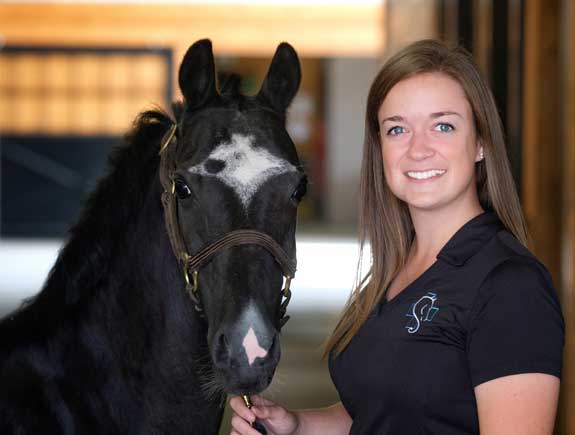
In the realm of equine sports medicine, regenerative therapies have become commonplace treatment options for the injured performance horse. Regenerative medicine is an encompassing term for treatment modalities that utilize the horse’s own body to encourage the best healing possible. This is achieved by promoting the development of increased blood flow to the damaged area. Increased blood flow allows for a more organized cellular repair process to minimize scar tissue formation with additional anti-inflammatory properties. Although these treatments are usually reached for in horses with soft tissue injuries they have many other potential applications within equine sports medicine. There are many therapies available, however the most commonly used include extracorporeal shockwave therapy, Platelet Rich Plasma (PRP), Interluekin-1 Receptor Antagonist Protein (IRAP), and stem cell therapy.
Extracorporeal shock wave therapy, most commonly referred to as ‘shockwave’, utilizes high pressure sound waves to transfer energy into the horse’s tissues. On a cellular level, this energy transfer results in neovascularization, or new blood vessel growth. This helps the body to build new healthy tissue in the area as well as remove byproducts which may be contributing to ongoing inflammation. There is a potential added benefit of short-term analgesia, or pain relief, for upwards of 4 days following treatment with shockwave therapy. For this reason, some organizations may require a withdrawal period between treatment and time of competition. The effects of shockwave have been studied on a variety of injuries. The most common application is in soft tissue injury, specifically tendon, ligament, or muscle damage. This modality may be combined with other regenerative therapies as well (PRP) to work synergistically within the body.
Platelet Rich Plasma, or ‘PRP’, involves collecting blood from the horse and processing the sample to draw out the platelets from within the blood to concentrate them. Platelets are known for their ability to help produce clotting factors to stop bleeding, however they also produce a wide array of other important growth factors which are vital to promoting cellular turnover, new tissue formation, and stimulation of new blood vessel growth. A sample of PRP may be deposited directly into a site of injury including a joint or lesion within a tendon/ligament. As mentioned above, recent studies have shown that utilizing shockwave therapy in conjunction with PRP causes platelets to release additional growth factors which only improves its ability to promote quality healing within the body.
Interluekin-1 Receptor Antagonist Protein, ‘IRAP’, is a similar product to PRP. It involves collecting blood from the horse and processing/incubating the sample in such a way to stimulate IRAP production which can then be concentrated into a serum and injected back into the horse at the site of injury. IRAP is a protein naturally occurring within the body whose main role is to reduce inflammation. In the incubation process, other growth factors and anti-inflammatory proteins are also produced providing additional benefits, similar to PRP. IRAP differs from PRP in that often there is enough sample collected to perform repeat treatments.
Stem Cell Therapy, as the name suggests, utilizes stem cells to aid in healing. These cells are known for their ability to differentiate into other cell types as well as coordinate healing and stem cells have significant anti-inflammatory capabilities. Certain types of tissue within the horse’s body are known for containing stem cells; adipose tissue (fat) and bone marrow. A sample of stem cells can be collected from the horse and cultured in a lab prior to reinjecting them into the site of injury.
These therapies all have many different uses and potential benefits within the scope of equine sports medicine. So how can we choose the right option for our horse? Unfortunately, there is no black and white answer available to us at this time.
Originally from Indiana, Dr. Liz Routh completed her doctorate of veterinary medicine at Iowa State University. Following graduation, she completed an equine internship focusing in general practice at Carolina Equine Hospital in North Carolina. She continued on as an associate veterinarian at another central North Carolina practice before moving back to the midwest, joining the team at Saginaw Valley Equine Clinic. Her main areas of interest include preventative medicine, herd health, dentistry and ophthalmology. You can email her at liz@saginawvalleyequine.com or visit her at www.saginawvalleyequine.com.



You must be logged in to post a comment Login